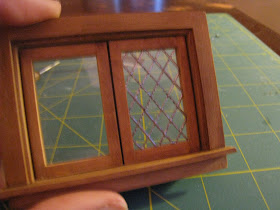If you're interested in making the casement window itself, go
here. This is the second half of a tutorial on making really authentic dollhouse miniature windows. I've been experimenting with this technique for a bit, and I think it works really well. Windows have always been a thorn in my side; commercially available products just don't cut the mustard. They usually aren't very well detailed, and take whatever project I'm working on completely out of scale.
Enter: lead tape. Yes, the same stuff golfers use to weight their clubs. You can get a roll of it online; I got mine on Amazon. The other supplies you'll need are,
- A double-end ball stylus; I like the Kemper DBSS. You can buy it here. Kemper makes really nifty tools, and a decent stylus is a terrific investment. It only costs three dollars!
- A paper pattern. I got mine by trolling the internet for pictures of window patterns I liked, and then resizing it on my computer. You can also draw your pattern freehand.
- DecoArt "Triple Thick" Brilliant Brush-On Gloss glaze. You can buy this at Michael's (or any big box craft store). I'm sure you can also find it online. Trust me, it's worth searching out the right materials. For clear, wavy panes--such as one finds in real old houses--this works the best. I know; I've tried several different glazes.
- A self-healing cutting mat.
- A metal ruler.
- A really sharp x-acto knife. I always buy extra blades every time I'm at the craft store. They dull very quickly--especially when you're working with a difficult material like lead.
- A window!
And now...
The first step is to cut out the pattern so it exactly fits inside your window pane.
I copied several different patterns I liked.
Here, I've fitted the pattern inside. It goes without saying that you should completely finish your window before moving on to this step! This window, in case you're interested, is a casement window I purchased from
Hobby Builders Supply.
This is lead tape. It's real lead. Be careful. Your next step is to cut off a piece and, from that, cut off a very thin strip, about 1/32" thick. The first few times you try this, it'll be pretty disheartening. After you've practiced awhile, though, you'll find that the process gets much easier. I cut my strips freehand.
Pull off the backing, and begin to lay the lead along the lines in the pattern. Use your stylus to gently press it in place. The tape has an adhesive backing, so it'll stay where you put it.
Here, I've laid a couple of strips.
It's slow going, but the learning curve is very steep. Don't be discouraged! You'll be making Tiffany-style windows in no time.
It's OK if the lines get a little messed; real lead paned windows weren't perfect, either.
Keep laying your strips...
Now, you get to start going the other way!
Using your stylus, press the crossed pieces together to form a joint.
Here's the first side completed!
And here it is without the pattern.
Now, flip it over and do the other side, matching the lines to each other as exactly as possible. It really is very important to do both sides. This is part of what creates such a level of realism.
Now, both sides are done.
Isn't it cool?
Occasionally, you'll look at your completed lead lights and something will seem out of place. You can use your stylus to mush the lines around a little bit. Make sure you're happy with how everything looks before you move on to the next step!
Now, do the other side. I know, I know, snore. But, really, it'll be so worth it in the end. And, you know, if you find this really boring, it's a great way to keep your hands busy while watching TV, etc.
Now, all four sides are complete.
Almost done!
The window looks pretty good, but not great. It won't be great until you glaze the panes. In this tutorial, I'm just making very simple clear panes. If anyone's interested, maybe later I can do a tutorial for stained glass?
I love this stuff. Using a very small brush (I prefer a pointed tip), gently fill in each pane. Go slowly and carefully, making sure the glaze touches each each edge completely. Otherwise, the glaze has a tendency to pull away from the lead.
Here, the right side is done and the left side isn't. I'm showing you the window like this for the purposes of contrast. Glaze really does make a difference.
It's wavy, just like real (antique) glass.
I like the way the light streams through.
And there you have it: the beginning steps. Of course, you'll want to glaze both sides, front and back. Then, let your window dry completely--ideally a full 24 hours. I like to do the front, then let it dry overnight before flipping it over to do the back, and then waiting another day before installing the window.
What do you think?





















































